The big thing these days is repeaters going mixed mode - So the repeater will work for conventional at the moment, and may also support P25, however in an emergency, it's really easy to turn conventional off, and just run P25, and possibly P25 encrypted (no one cares right?)
Hams have gone P25? Really? That's a lot of expense for equip and overhead assigning NACs etc.
















